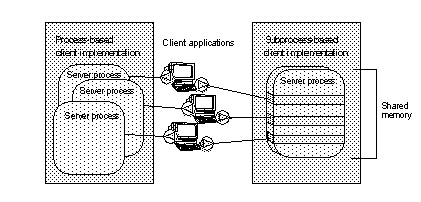Adaptive Server client tasks are implemented as subprocesses, or “lightweight processes,” instead of operating - system processes, as subprocesses use only a small fraction of the resources that processes use.
Multiple processes executing concurrently require more memory and CPU time than multiple subprocesses. Processes also require operating – system resources to switch context (time-share) from one process to the next.
The use of subprocesses eliminates most of the overhead of paging, context switching, locking, and other operating - system functions associated with a one process-per-connection architecture. Subprocesses require no operating – system resources after they are launched, and they can share many system resources and structures.
Figure 3-1 illustrates the difference in system resources required by client connections implemented as processes and client connections implemented as subprocesses. Subprocesses exist and operate within a single instance of the executing program process and its address space in shared memory.
Figure 3-1: Process versus subprocess architecture

To give Adaptive Server the maximum amount of processing power, run only essential non-Adaptive Server processes on the database machine.